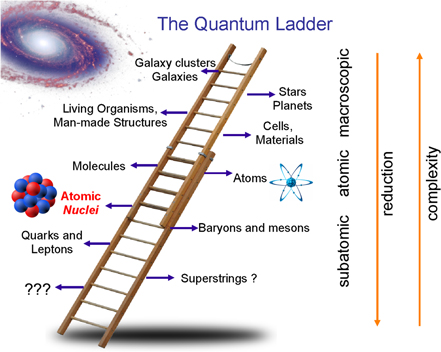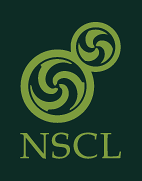Looking Through the Crystal Ball at Nuclear Structure Physics
Taken from the Jphys+ blog by
Nuclei are at the core of everything in day to day life. They are the building blocks of the smallest nanostructures and the biggest stars, defining the behaviour and properties of every object. Understanding how they work and interact is a fundamental science vital to applications in the real world as well as pure research.
It might not be as glamorous as the hunt for dark matter or the Higgs boson, but this is science that arguably affects more fields than any other.
And that’s why renowned nuclear structure expert Witek Nazarewicz has put pen to paper (fingers to keyboard?) in a new article in JPhysG titled ‘Challenges in nuclear structure theory‘, giving his perspectives on the status and future of this vital topic. Don’t click off just yet, this is an article that almost anyone can read and enjoy.

Quantum ladder: physical systems at various scales, from microscopic to macroscopic. See figure 1 in the paper, Copyright IOP Publishing.
So, nuclei are at the centre of the quantum ladder, and Witek says that this position drives key questions :
- Where do nuclei and elements come from?
- How are nuclei made and organized?
- How can nuclei be exploited to reveal the fundamental symmetries of nature?
- What are practical and scientific uses of nuclei?
Naturally, we’re far from understanding everything, but we’ve come a long way. There are a raft of theories being used in different scenarios, like Quantum Chromodynamics (QCD), Effective Field Theory (EFT), Density Functional Theory (DFT) and many more. This may seem over complicated, but this is important because of the wide variety and properties of nuclei – QCD is used at the very smallest scales and represents the physics of the strong force, whilst EFT allows us to moves up to two, three or many body interactions. Moving up again, DFT allows calculations about heavy, complex nuclei and enables researchers to fit data with theory in subjects like shape coexistence, nuclear fission and heavy-ion fusion.
As a result of these theories, their broad scope and their increasing complexity, more dependence is then placed on computer science. Moreover, linking these theories with experiments and ensuring they are testable becomes even more challenging. That is where collaborations like NUCLEI come in: an initiative that involves nuclear structure theorists, computer scientists and mathematicians from 16 institutions. By bringing high-performance computing and computer science techniques to issues like the many-body problem we open up new possibilities to design new experiments and ensure we get the most out of experiments and data that we already have.
What else is in store? Witek took a look through his crystal ball, here are just a few of his visions for the next 10-15 years:
- We will describe the lightest nuclei in terms of lattice QCD and, by the way of coupling with EFT, we will understand the QCD origin of nuclear forces.
- By exploring quantum many-body approaches to open systems, we will understand the mechanism of clustering and explain properties of key cluster states and cluster decays.
- By taking advantage of realistic many-body theory, we will unify the fields of nuclear structure and reactions.
- By taking the full advantage of extreme-scale computers, we will master the tools of uncertainty quantification. This will be essential for enhancing the coupling between theory and experiment—to provide predictions that can be trusted.
Taken from the Jphys+ blog by



